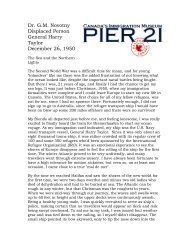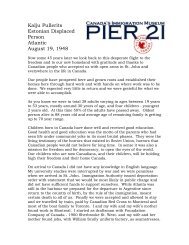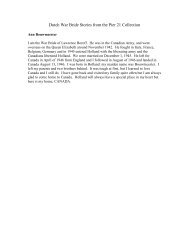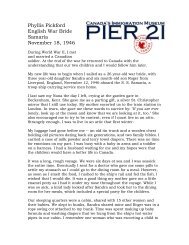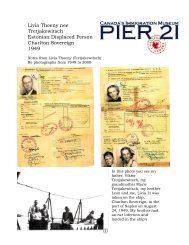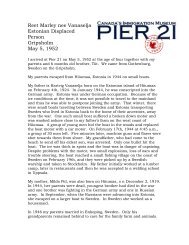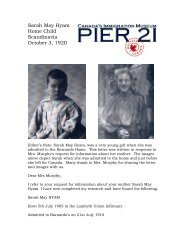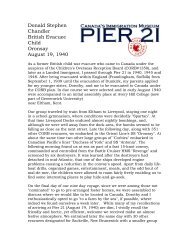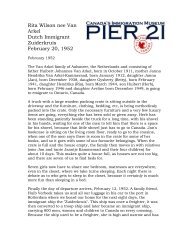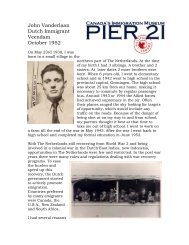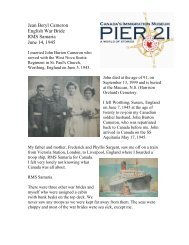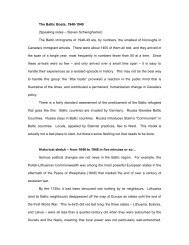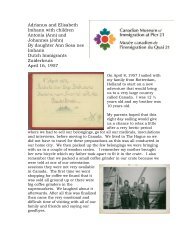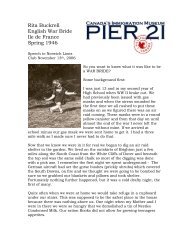Dutch and German Immigrants The Prins Family - Pier 21
Dutch and German Immigrants The Prins Family - Pier 21
Dutch and German Immigrants The Prins Family - Pier 21
Create successful ePaper yourself
Turn your PDF publications into a flip-book with our unique Google optimized e-Paper software.
In the early days, fishing was done with flat-bottomed boats they wereable to beach. Short trips were made of about a week in duration.Caught fish were kept alive in so called “buns” or salted <strong>and</strong> preserved inthat way. When they arrived at the beach, the fish were sold to thebuyers who took them from there to the outlying towns for distribution<strong>and</strong> re-sale. Later on when IJmuiden came into being, botters were used<strong>and</strong> after that trawlers.Sometimes competition came from the catches of English fisherman whobrought their harvest in by freighter. This of course was not much to theliking of the local fishermen, as it tended to lower the prices. <strong>The</strong>Egmonder people took matters into their own h<strong>and</strong>s by throwing the'English' fish back into the sea. This act brought in the federal policeforce, the Marechaussee, trying to prevent this unlawful deed. Fightserupted <strong>and</strong> one of my great-gr<strong>and</strong>fathers, Teunis Zwart, bashed one ofhis wooden shoes on the head of one of the policemen. He was convicted<strong>and</strong> spent three months in jail in the town of Breda.<strong>The</strong> first fish auction market was a private one, located close to theoriginal locks. Later on after the fishing harbour was dug, thegovernment run auction market was established there, <strong>and</strong> all thefishing boats moved into that harbour.Opa <strong>Prins</strong>, when he was an active fisherman, was master upon one of thetrawlers, owned by the gr<strong>and</strong>father of Uncle Dirk de Groot.Fishing with the dragnets was usually done from one side of the trawler.<strong>The</strong> other side was kept as a spare, in case there were repairs to be madeto the used net. After a fishing period of approximately four hours, thehaul was dumped into compartments on the ship’s deck, processed <strong>and</strong>sorted. <strong>The</strong> mate h<strong>and</strong>led the steam winch to pull in the net. It was hisjob as well to insure a proper storing <strong>and</strong> icing of the catch.<strong>The</strong> warehouse at the Haringstraat was purchased when the Praxis hadplans to exp<strong>and</strong> into the fishery with herring nets, but those plans werenever realized.Klaar still remembers the day my dad <strong>and</strong> mother came to theKennemerlaan to ask for permission to get married, as was the customthose days. This took place in the stateroom, my mother crying. Omawasn’t impressed but she did the answering. Apparently the answer wasyes <strong>and</strong> they got married.From his early childhood, Klaar spent time at Aunt Antje’s place having afull cousin Jack v d Kuil, as a playmate. One time, the v d Kuil familywas sitting around the kitchen table while Klaar hid under the table.



